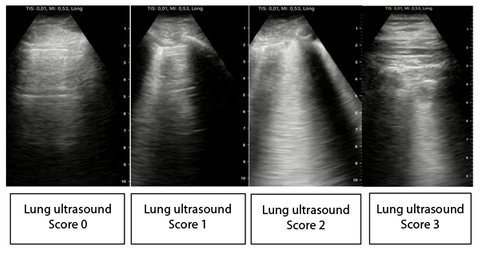
This is an AI for Health MSc project. Students are elgible to receive a monthly reimbursement of €500,- for a period of six months. For more information please read the requirements.
Clinical problem
The COVID-19 pandemic causes health care challenges around the world. Its major morbidity and mortality is caused by COVID-19 pneumonia and respiratory failure. Fast diagnosis and classification of the severity of the disease is of vital importance. A physical examination and chest X-ray are not sufficient to determine the severity of the disease. Most patients with a suspicion of COVID-19 will therefore undergo a CT scan, but this results in radiation exposure and is only performed within a radiology department of a hospital which limits its accessibility. Ultrasound imaging could resolve these problems, since it is does not use ionizing radiation and can be performed at the point-of-care. Moreover, in COVID-19 pneumonia it has comparable diagnostic accuracy compared to CT. Ultrasound devices have become very portable and can be connected to laptops, tablets and even smartphones. Several point-of-care ultrasound (POCUS) devices have become available on the market in recent years. Some examples are: Butterfly iQ, Philips Lumify, Telemed MicrUs Pro and the Clarius C3. Ultrasound requires a trained sonographer that can both acquire and interpret the images, which limits the use of these devices outside the hospital environment.
Solution
In this project we will make use of a standardized acquisition protocol and develop AI algorithms that will automatically interpret the ultrasound images. This makes it possible to widely perform lung ultrasound for patients suspected of COVID-19 with minimal amount of training. This would enable fast triage also outside hospitals and would make follow-up of patients over time without any radiation burden possible.
Tasks
- Learn about ultrasound imaging and the acquisition protocol that is used
- Development of deep learning algorithms
- Evaluation of the developed algorithms
- Optimize the algorithms on computational efficiency
- Development of a web application for automated classification of COVID-19
Innovation
When the algorithms have sufficient sensitivity and accuracy, and are able to run on a smartphone, they can be used for development of a point-of-care ultrasound solution that makes it possible for health-care personnel to perform the predefined acquisition protocol with minimal amount of training, since the developed algorithm will perform the automated interpretation. This could enable wide spread use of POCUS for fast triage of COVID-19 suspected patients. The development of a web-based application will enable widespread use of the state-of-the-art algorithm by clincians and health-care personnel.
Requirements
- Students with a major in data science, computer science, or artificial intelligence in the final stage of master level studies are invited to apply.
- Interest in (medical) image analysis and machine learning.
- Affinity with programming in Python and with deep learning packages (e.g. PyTorch) is required.
Information
- Project duration: 6 months
- Location: Radboud University Medical Center
- For more information, please contact Thomas van den Heuvel



